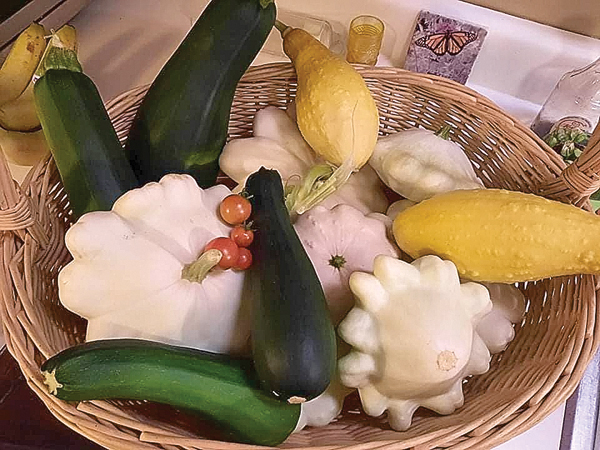
Laura Dean Bennett
Staff Writer
Well, it’s harvest time again – the time of year when the annual jokes about bags of zucchini appearing on the porch make their rounds.
Like Santa, the Zucchini Fairy leaves bags of zucchini and other squashes on porches every night.
This blessed largesse from our own and our neighbors’ gardens keeps us scouring our cookbooks for ever more inventive recipes for the ubiquitous vegetables.
And zucchini isn’t the only squash being left on our porches.
There are all kinds of squashes, getting riper by the minute all around us.
But rather than making jokes about them, perhaps we should be a little more respectful of these important vegetables.
They are among the world’s oldest crops.
The squash family – cucurbitacea – includes nearly 1,000 species and is indigenous to Central and South America, where it was a key food source for the entire region.
Central American farmers were growing squash more than 8,000 years ago, and many varieties of squash quite similar to those grown today were being cultivated even 10,000 years ago in parts of Mexico.
It was brought to North America by many tribes of ancient peoples and became the oldest cultivated food crop in North America.
Native Americans were planting squash long before it became their famous practice to plant the “three sisters” (squash, corn and beans) together.
In addition to a ton of squashes and zucchinis, the cucurbitacea family includes more varieties of pumpkins, watermelons and gourds than you can shake a stick at.
Thank goodness squashes were being grown by Native Americans when Europeans arrived on the shores of the New World.
While some may say there’s nothing more American than apple pie, the first of our ancestors, trying to survive in the harsh conditions of the original European settlements, would probably have disagreed.
Although Virginia and New England settlers may have initially turned up their noses at the Native American’s squash crops, after struggling to survive in a hard winter, they soon learned to appreciate squash and pumpkin as staples in their diet.
Travelling with members of a Native American tribe in 1636, one French explorer wrote that “the squashes last sometimes four and five months, and are so abundant that they are to be had almost for nothing, and so good that, on being cooked in the ashes, they are eaten as apples are in France.”
Squash were sliced or baked whole in the coals of a fire, boiled or just roasted whole, drizzled with animal fat and honey and eaten skin and all.
All the seeds from a squash were considered precious.
Some seeds would be dried and carefully saved for next year’s crop and the rest would have been eaten. They would have been roasted and combined with nuts and dried fruits – in an early version of trail mix.
The squash crops were gathered and eaten as they ripened – from unripe to completely ripe.
Colonists learned to eat tender young squash blossoms from their Native American neighbors, who gathered them early in the morning before the flowers opened.
Since some squashes are a lot like their cousins, the gourds, they also had other uses.
Even their hard shells had a use.
They served as containers (to gather or hold food or carry or even store water) and utensils (such as scoops or spoons) for centuries.
Squashes come in many varieties.
There are many summer squashes (for example, zucchini, crookneck and yellow squash), a score of winter squashes (butternut, acorn, hubbard, spaghetti, to name a few) and a seemingly endless variety of gourds and pumpkins.
Squashes can be solid-colored, speckled or striped, smooth-skinned or as knobbly as a warty toad.
They come in all sorts of colors- green, tan, yellow, brown, red, orange and even white or blue.
Squashes are a good source of minerals, carotenes and vitamin A, with moderate quantities of vitamins B and C.
Summer squash is high in water content and low in calories.
We often get overwhelmed by an over-abundance of zucchini and other squashes when they seem to come in by the bushel.
We fall back on our tried and true recipes and forget to try new and innovative ways to use them.
Remember that squashes of all kinds can always be added to salads, soups and & pasta salads, and even be substituted for pasta in Italian dishes like spaghetti and lasagna.
Fashion fettucine-like noodles with a vegetable peeler, slicing lengthwise down a peeled or unpeeled zucchini. Or make zucchini-lasagne noodles with a wide, sharp knife.Slice down vertically along the sides of the zucchini for long, thin pasta-like pieces.
Or make short, rice-like zucchini noodles by shredding the zucchini on a box grater. Press out excess liquid and use the short noodles in soups or stir-fry as you would rice noodles.
Zucchinis are perfect for making “pizza boats.”
Slice them in half, scoop out and roast, then fill with pizza toppings and broil or bake until the cheese is melted.
Grated zucchini mixed with some cheese and formed into oblong shapes can be tossed with a little oil, broiled and served as “zucchini tots,” a crispy substitute for tater tots.



